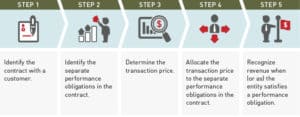Revenue Recognition
Revenue Recognition
Revenue recognition is an accounting principle...
Revenue recognition is an accounting principle, which refers to how revenue is treated or recognized and is one of the four main principles in the US Generally Accepted Accounting Principles (GAAP).
The cornerstone of investing is accrual or matching revenues with expenses. It is also the main difference between cash basis accounting and accrual basis accounting. In cash basis accounting, revenues are simply recognized when cash is received no matter when and how the services were performed or goods delivered. In accrual basis accounting, revenues are recognized when they are realized or realizable and earned no matter when cash is received.
 US GAAP for revenue recognition consists of over 200 pronouncements by various standard setting bodies that is hard to retrieve and sometimes inconsistent. Despite the large number of revenue recognition pronouncements, there is little guidance for service activities, which is the fastest growing part of the U.S. economy. Revenue recognition is a primary source of restatements due to application errors and fraud. Those restatements decrease investor confidence in financial reporting.
US GAAP for revenue recognition consists of over 200 pronouncements by various standard setting bodies that is hard to retrieve and sometimes inconsistent. Despite the large number of revenue recognition pronouncements, there is little guidance for service activities, which is the fastest growing part of the U.S. economy. Revenue recognition is a primary source of restatements due to application errors and fraud. Those restatements decrease investor confidence in financial reporting.
In order for revenue recognition to be achieved, it must meet two key conditions:
There are 4 Criteria for Revenue Recognition.
Completion of the earnings process and 2) Assurance of payment. According to the US Security Exchange Commission SAB104: “revenue generally is realized or realizable and earned when all of the following criteria are met:
- Persuasive evidence of an arrangement exists;
- Delivery has occurred or services have been rendered;
- The seller’s price to the buyer is fixed or determinable; and
- Collectibility is reasonably assured”.
Within Generally Accepted Accounting Principles (GAAP Revenue recognition Rules) there are multiple ways to recognize revenues and can look dramatically different depending on the method chosen even when the economic reality is the same. Revenues can be recognized on a sales basis, percentage of completion, cost recoverability and installment. Using the sales basis method, revenue is recognized at the moment the goods or services are transferred to the buyer. In this case, revenue is not recognized even if cash is received before the transaction is complete. The percentage of completion method is used when there is a long-term legally enforceable contract and it is possible to estimate the percentage of project completion, revenues and costs.
In this method, no profit is recognized until all expenses incurred to complete the project have been recovered. In the installment method, gross profit is only calculated in proportion to cash received. The cost recoverability method of revenue recognition is the most conservative.
